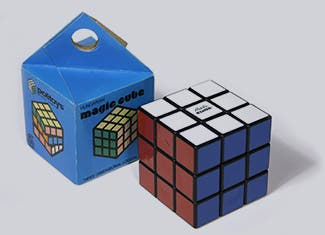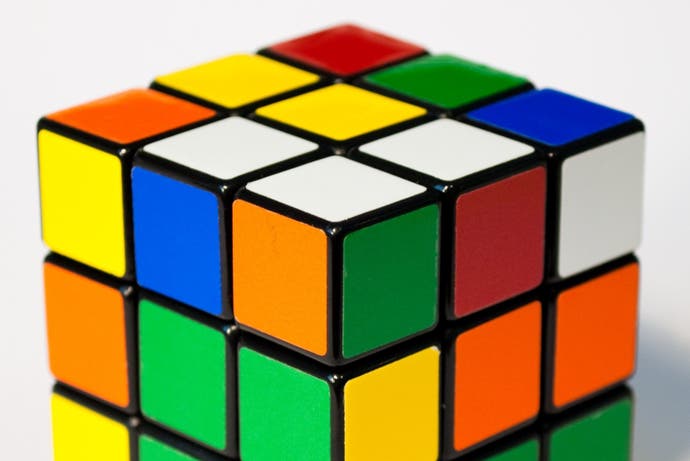Quintillions of permutations: The Rubik's Cube at 40
Stick or twist.
There's a guy in our office who can solve the Rubik's Cube really quickly. Not under-ten-seconds quickly like the very best Speedcubers, but he can still scowl his way through the process in less time than it takes a kettle to boil. If you work in an office, there may well be someone there who can solve the Cube, too. You'll probably know, because they'll probably have a Rubik's Cube visible on their desk. That's the problem with having a skill as fiercely specialised as this - it doesn't really come up much unless you force it.
It may come up a little more at the moment because the Rubik's Cube just turned 40. The twisty-turny puzzle is the work of the Hungarian architect Erno Rubik, and he developed it when he was 30 years old. It made perfect sense to me when I learned that Dr Rubik's a professor of architecture and that he was a teacher as well as a practitioner at the time. The Rubik's cube is a little piece of corporate sculpture, really. It hides its mechanical complexities from sight while constantly hinting at them the way a lot of great buildings do, as well. Despite the fact it wasn't designed for his students (it wasn't even designed as a puzzle) it's also got the unmistakable whiff of an educational enterprise to it - although it would be hard for most people to pinpoint exactly what it is you're meant to be learning.
What you're learning, of course, is how to solve the Rubik's Cube, and, judged purely as a puzzle game it's fascinating that so many people find such a seemingly austere gadget entertaining. Most of the champions of the Rubik's world seem more like musicians than players - to watch a master at work is like seeing an instrument being bustled into complex life rather than a puzzle being solved. And the process of solving is often so austere, too, with those "algorithms", or standard sequences, that have to be internalised if you want to get the moves down to a manageable level.
As insanely successful as it is - Dr Rubik's invention is often described as the world's best-selling toy - the Cube could almost be seen as an example of the gulf between a designer's intention and an audience's eventual behaviour, in fact. If he wanted so many people to just memorise the tricks for the puzzle's completion, then Dr Rubik's was possibly being a little mean when he put his invention on sale. I suspect that he actually expected players to approach the Cube with a more experimental attitude - that he expected players to discover their own algorithms rather than simply absorb the famous ones. Does this move get me anywhere? How about this one?

The enduring genius of the Rubik's Cube, though, is that it's not purely a puzzle game. For millions of us lesser Rubik's devotees around the world who've never had the patience to either learn the process or remove and replace all those fiddly coloured stickers, it's just a brilliant object to have on the desk, an excellent, personable toy to fiddle aimlessly with every now and then. I love the almost muscular tension you feel inside the Cube when you give it a twist, that sense of a compact hidden world where everything fits tightly in place. I also love the amiable craziness that takes hold of me whenever I'm faced with a solved Cube and I start to mess it all up again. I know I'm taking something perfect and muddling it in a way that's probably permanent. I have no ability to solve it after all, and I'm sufficiently chaotic that I don't really want to solve it anyway. There's something sort of sad about a solved Rubik's Cube I'd argue, just as it's hard not to feel a bit mopey when you're putting the Monopoly board away and clearing the plastic rubble of toy-town capitalism. There's an emptiness to victory, an emptiness to completion. It's the enduring quandary of games.
Weirdly enough, for the company that looks after the Rubik's Cube, the Cube itself is never complete. There have been other Rubik's puzzles, for one thing, but while I know at least one friend who gets very excited about the Rubik's Snake, none of the follow-ups have the same iconographic power as the Cube - since it borrows, inevitably, the iconographic power of the cube. Beyond that, the outfit's just released a brand new model of the Cube itself. The new Rubik's Cube is almost impossible to dismantle, apparently, and it's also made in a way that means there are no longer stickers to be taken off and reapplied by cheaters.
I'm going to buy one, and then I'm going to mess it up and not solve it. Again. Happy birthday, Dr Rubik's.

